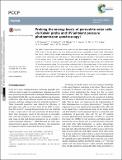Probing the energy levels of perovskite solar cells via Kelvin probe and UV ambient pressure photoemission spectroscopy
Date
07/08/2016Author
Grant ID
EP/K015540/1
EP/K022237/1
EP/M025330/1
WRMA 2012/R2
Keywords
Metadata
Show full item recordAbstract
The field of organo-lead halide perovskite solar cells has been rapidly growing since their discovery in 2009. State of the art devices are now achieving efficiencies comparable to much older technologies like silicon, while utilising simple manufacturing processes and starting materials. A key parameter to consider when optimising solar cell devices or when designing new materials is the position and effects of the energy levels in the materials. We present here a comprehensive study of the energy levels present in a common structure of perovskite solar cell using an advanced macroscopic Kelvin probe and UV air photoemission setup. By constructing a detailed map of the energy levels in the system we are able to predict the importance of each layer to the open circuit voltage of the solar cell, which we then back up through measurements of the surface photovoltage of the cell under white illumination. Our results demonstrate the effectiveness of air photoemission and Kelvin probe contact potential difference measurements as a method of identifying the factors contributing to the open circuit voltage in a solar cell, as well as being an excellent way of probing the physics of new materials.
Citation
Harwell , J R , Baikie , T K , Baikie , I D , Payne , J L , Ni , C , Irvine , J T S , Turnbull , G A & Samuel , I D W 2016 , ' Probing the energy levels of perovskite solar cells via Kelvin probe and UV ambient pressure photoemission spectroscopy ' , Physical Chemistry Chemical Physics , vol. 18 , no. 29 , pp. 19738-19745 . https://doi.org/10.1039/C6CP02446G
Publication
Physical Chemistry Chemical Physics
Status
Peer reviewed
ISSN
1463-9076Type
Journal article
Description
This work was supported by the Engineering and Physical Sciences Research Council (grant codes EP/M506631/1, EP/ K015540/01, EP/K022237/1 and EP/M025330/1). IDWS and JTSI acknowledge Royal Society Wolfson research merit awards.Collections
Items in the St Andrews Research Repository are protected by copyright, with all rights reserved, unless otherwise indicated.

